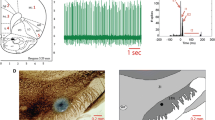Summary.
Dopaminergic terminals within the caudate-putamen are located in an ideal position to modulate the corticostriatal system. Since this is the major afferent system of the striatum, dopamine has very powerful effects on striatal electrophysiological activity. The striatum is a regionally specialized multifunctional nucleus. It is therefore important to determine if dopamine has the same modulatory effects within different areas of the nucleus.
The effects of 2.5 mg/Kg D-amphetamine (IP) on cortical stimulation evoked and basal multiple unit activity (MUA) was measured in 7 dorsal and 7 ventral striatal areas of the urethane anaesthetized rat. In general, amphetamine caused an increase in the basal activity and a decrease in the cortical stimulation evoked activity. However, there were both qualitative and quantitative regionally dependent differences in these responses. The effect on basal MUA was more pronounced in the dorsal and caudal areas whereas the effect on cortical stimulation evoked MUA was more pronounced in the ventral areas.
The electrophysiological effects of amphetamine within the striatum were correlated with its regionally dependent effects on extracellular dopamine. This produced a measure of the effects of striatal dopamine on regional electrophysiological activity. This information was also used to determine the mathematical relationship between dopamine concentration change and the change in MUA. These data indicate that the excitatory effects of amphetamine-induced dopamine release on the non-stimulated MUA progressively increase along the rostro-caudal axis of the nucleus. In addition, the effects were more pronounced in the ventromedial as compared to the ventrolateral areas. These effects correlated best with the rate of change in dopamine concentration. In the dorsal striatum amphetamine-induced increases in dopamine had a regionally homogeneous inhibitory effect on the stimulated MUA. In the ventral striatum however, it had a progressively stronger effect along the rostro-caudal axis. These effects correlated best with the absolute change in dopamine concentration.
Similar content being viewed by others
Author information
Authors and Affiliations
Additional information
Received April 17, 2002; accepted December 2, 2002 Published online March 5, 2003
Authors' address: Dr. G. Glynn, School of Pharmacy and Allied Health Professions, Creighton University, 2500 California Plaza, Omaha, NE 68178, U.S.A., e-mail: GGlynn@creighton.edu
Rights and permissions
About this article
Cite this article
Glynn, G., Ahmad, S. Regional variations in the physiology of the rat caudate-putamen. 2. Effects of amphetamine and amphetamine induced dopamine release on basal and cortical stimulation evoked multiple unit activity. J Neural Transm 110, 461–485 (2003). https://doi.org/10.1007/s00702-002-0802-8
Issue Date:
DOI: https://doi.org/10.1007/s00702-002-0802-8




